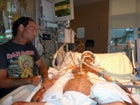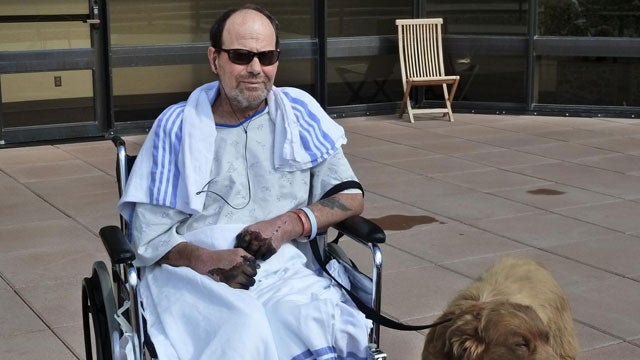The bubonic plague, or “Black Death”, wiped out 60 percent of Europe’s population during the Medieval period. That disease still exists. In the late 1800s, a strain spread from China to the rest of the world via rats on steamships, and caused outbreaks in many cities in the United States. Rat eradication efforts curbed the threat in urban areas, but the fleas that carried the bacterium spread to rural areas on the backs of other small mammals. Of the 1,000 to 2,000 global cases reported each year, . In 2012, PAUL GAYLORD came close to death when he contracted the disease outside of his home in Prineville, Oregon. PAUL and his wife, DEBBIE GAYLORD, share their story.
 Gaylord in the hospital
Gaylord in the hospitalPaul: Our cat had been missing for a few days, when he came home on the night of Saturday June 2. His face was all swollen and he didn’t look well. I thought he had something stuck in his throat, maybe a mouse.
Debbie: I just thought the cat was choking to death. He looked awful sick. My husband and our friend went outside to work on the cat.
Paul: I reached into his mouth to try and pull it out, but didn’t find anything. After a couple of attempts, the cat got away and ran under the porch. We noticed that my friend had a small cut on her hand and I had a puncture wound on my left index finger from the cat’s teeth. We squeezed out the blood and washed our hands with bleach and peroxide.
On Sunday, the cat came out from under the porch. Unfortunately, we had to put him down.
I went to work Monday for a couple hours and came home before lunch because I had flu-like symptoms and a temperature of 103. I went to the VA, but they couldn’t see me. They called later and said it would be about 15 days before they could. Tuesday, I went to the urgency care clinic in Redmond. They didn’t know what I had, but they gave me an antibiotic for cat scratch fever.
By Saturday, I was really sick. The area under my armpit swelled to the size of a lemon. I didn’t know it then, but they call that swelling a bubo. That’s probably what the cat had in his throat. I started coughing up stuff. I had a fever and chills. It felt like the worse case of flu I ever had.
Debbie: We went out together to pick up someone’s car. I looked over at him as I was driving and he was gray and sweating. I said, “No, we’re not going to get the car.” I drove him back to the urgency care.
Paul: The doctor took one look at me and called an ambulance, which took me to the hospital. Once there, one of the doctors diagnosed me immediately with the plague. All of the other doctors said they don’t think they would have caught it. He saved my life, but I still paid a price.
Debbie: They put him in the ICU. On Sunday, they sent him over to the hospital in Bend.
Paul: That’s when I went into a coma.
Debbie: I thought I was going to lose him when he went into that coma. They weren’t telling me much about the prognosis because it was such a rare diagnosis. I didn’t leave the hospital for two weeks. His mother and sister were there every step of the way too.
One night, the doctor brought four of us into a room. He closed the door and then said Paul probably wasn’t going to make it. He said we had to make a decision. We decided the next day we were going to unplug everything.
Paul: That morning I woke up. I was in the ICU, and, of course, I couldn’t talk because of the tracheotomy. I couldn’t motion with my hands because they were stiff and black. I felt horribly weak and I couldn’t lift my arm off my chest. I had double vision, blurry vision, and my blood pressure was real low. I had lost 30 pounds. I wasn’t pretty.
My doctor said, “You’re famous, dude. You have the plague, but you’re famous.” He explained what happened and said, “You might lose your fingers. You might also lose your toes.”
I had about ten doctors, and as many nurses, too. They all said they didn’t think I was going to wake up. One doctor said that I had one foot in the grave and another foot on a banana peel.
Debbie: The nurse came to me and said he was awake. She was in shock. I think he must have heard what was going on. He probably thought, “Nuh uh, that ain’t happening. You’re not going to unplug me.”
Paul: I was off and on life support over the course of the next month. The organs had sucked all the blood out of my extremities and turned my fingers and toes into something like hard plastic. Originally, the doctors said they were going to cut off my hands and feet, but then they decided to wait for self-amputation because I was getting gangrene.
Now I have no fingers and only partial thumbs. I lost about a third of one foot and all of the toes on the other. Both my lungs collapsed and my heart stopped a couple of times too. The doctors said I was going to be on dialysis the rest of my life, but my kidneys and the rest of my body came back.
They told me they were going to keep me until November, but I got out in August. I eventually moved into a new house thanks to help from the entire community. The Band of Brothers, a veteran’s group, tore down our old house. The county waived all of the building permits on the land. My niece and her husband built us a new house. I was in a wheelchair for about four or five months, but I’m not anymore.
The health department came up here looking for plague and they couldn’t find anything in the area. We still have another cat. I don’t blame the cats, but you need to be aware that they can carry it. Our cat goes outside. He lays in bed with me all of the time. You can’t hide the rest of your life, you know?
A couple of weeks after I went in the hospital, our friend ended up testing positive for the plague too. She got the right antibiotics because I had already been diagnosed.
Debbie: I didn’t know anything about the plague before this. I didn’t even think it existed anymore. Right after Paul got it, a little girl in Colorado got diagnosed early with it. We like to think that since Paul was in all the newspapers and on TV, the doctors were looking for it. We like to think that he saved her little life.
EXPERT OPINION:
Plague does still occur in the Western United States, usually in rural and semi-rural areas. The bacteria typically infect rodents such as squirrels and prairie dogs, but cats, dogs, and large predators can also be affected. People may contract plague if they’re bitten by infected fleas or come in contact with infected animals, such as this cat.
To avoid plague, use flea control products on your pets, wear gloves when handling sick animals, and use a shovel to move dead animals. If you become ill with a high fever or a swollen, painful lymph node, see a doctor as soon as possible. The best thing you can do is tell your doctor if you have been in contact with a dead or sick animal, spent time outdoors in the Western United States, or have pets. Plague is a treatable disease, but only if a doctor thinks of it and gives the right antibiotics in time.
—Christina Nelson, MD, MPH, Medical epidemiologist at the
To follow Paul Gaylord’s progress, go to his . For information on how to contribute to his recovery, send an email to donatetopaul@aol.com.


